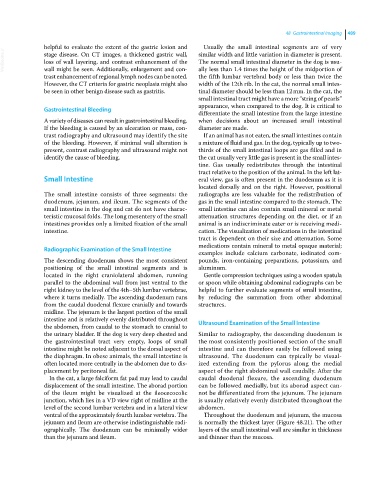Page 521 - Clinical Small Animal Internal Medicine
P. 521
48 Gastrointestinal Imaging 489
helpful to evaluate the extent of the gastric lesion and Usually the small intestinal segments are of very
VetBooks.ir stage disease. On CT images, a thickened gastric wall, similar width and little variation in diameter is present.
The normal small intestinal diameter in the dog is usu
loss of wall layering, and contrast enhancement of the
wall might be seen. Additionally, enlargement and con
the fifth lumbar vertebral body or less than twice the
trast enhancement of regional lymph nodes can be noted. ally less than 1.4 times the height of the midportion of
However, the CT criteria for gastric neoplasia might also width of the 12th rib. In the cat, the normal small intes
be seen in other benign disease such as gastritis. tinal diameter should be less than 12 mm. In the cat, the
small intestinal tract might have a more “string of pearls”
appearance, when compared to the dog. It is critical to
Gastrointestinal Bleeding
differentiate the small intestine from the large intestine
A variety of diseases can result in gastrointestinal bleeding. when decisions about an increased small intestinal
If the bleeding is caused by an ulceration or mass, con diameter are made.
trast radiography and ultrasound may identify the site If an animal has not eaten, the small intestines contain
of the bleeding. However, if minimal wall alteration is a mixture of fluid and gas. In the dog, typically up to two‐
present, contrast radiography and ultrasound might not thirds of the small intestinal loops are gas filled and in
identify the cause of bleeding. the cat usually very little gas is present in the small intes
tine. Gas usually redistributes through the intestinal
tract relative to the position of the animal. In the left lat
Small Intestine eral view, gas is often present in the duodenum as it is
located dorsally and on the right. However, positional
The small intestine consists of three segments: the radiographs are less valuable for the redistribution of
duodenum, jejunum, and ileum. The segments of the gas in the small intestine compared to the stomach. The
small intestine in the dog and cat do not have charac small intestine can also contain small mineral or metal
teristic mucosal folds. The long mesentery of the small attenuation structures depending on the diet, or if an
intestines provides only a limited fixation of the small animal is an indiscriminate eater or is receiving medi
intestine. cation. The visualization of medications in the intestinal
tract is dependent on their size and attenuation. Some
medications contain mineral to metal opaque material;
Radiographic Examination of the Small Intestine
examples include calcium carbonate, iodinated com
The descending duodenum shows the most consistent pounds, iron‐containing preparations, potassium, and
positioning of the small intestinal segments and is aluminum.
located in the right craniolateral abdomen, running Gentle compression techniques using a wooden spatula
parallel to the abdominal wall from just ventral to the or spoon while obtaining abdominal radiographs can be
right kidney to the level of the 4th–5th lumbar vertebrae, helpful to further evaluate segments of small intestine,
where it turns medially. The ascending duodenum runs by reducing the summation from other abdominal
from the caudal duodenal flexure cranially and towards structures.
midline. The jejunum is the largest portion of the small
intestine and is relatively evenly distributed throughout Ultrasound Examination of the Small Intestine
the abdomen, from caudal to the stomach to cranial to
the urinary bladder. If the dog is very deep chested and Similar to radiography, the descending duodenum is
the gastrointestinal tract very empty, loops of small the most consistently positioned section of the small
intestine might be noted adjacent to the dorsal aspect of intestine and can therefore easily be followed using
the diaphragm. In obese animals, the small intestine is ultrasound. The duodenum can typically be visual
often located more centrally in the abdomen due to dis ized extending from the pylorus along the medial
placement by peritoneal fat. aspect of the right abdominal wall caudally. After the
In the cat, a large falciform fat pad may lead to caudal caudal duodenal flexure, the ascending duodenum
displacement of the small intestine. The aborad portion can be followed medially, but its aborad aspect can
of the ileum might be visualized at the ileocecocolic not be differentiated from the jejunum. The jejunum
junction, which lies in a VD view right of midline at the is usually relatively evenly distributed throughout the
level of the second lumbar vertebra and in a lateral view abdomen.
ventral of the approximately fourth lumbar vertebra. The Throughout the duodenum and jejunum, the mucosa
jejunum and ileum are otherwise indistinguishable radi is normally the thickest layer (Figure 48.21). The other
ographically. The duodenum can be minimally wider layers of the small intestinal wall are similar in thickness
than the jejunum and ileum. and thinner than the mucosa.

